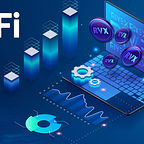DeFi Looping
Since crypto is more scalable and a substitute for the traditional finance system. Its been providing effective solutions to utilize your assets and money in different ways through DeFi.
Yet investors would like to borrow money from the market against their assets rather than in the form of collateralized loans, which only pay 70% of the collateral in return.
However, DeFi is the way to improve your lending and borrowing experience with its looping feature on DApps. It’s exciting to generate a yield on whatever you lend or borrow.
Unlike CeFi, borrowing and lending are now more efficient and transparent in DeFi, without your privacy being compromised.
Let’s take a deep dive into DeFi looping and its Methods.
What is Looping
As its name implies, looping refers to lending your borrowed assets repeatedly to prevent the capital from liquidation and generate maximum yield by creating a loop.
i.e., you deposit one $BTC to a lending platform and borrow 75% of the value of your collateral in return. After the first successful transaction, purchase another 0.75 $BTC from borrowed money, deposit it again to get another 75% against your collateral, and repeat the action.
That’s how the user creates a loop. In this process, you provide more collateral, which increases the total supplied value. In a simple sentence, now the user holds 1.75 $BTC.
If the price of BTC goes up, Increased supply will maximize the profit, as now user have more $BTC than before.
If the user gets paid on both sides, Lending or borrowing, APR will increase simultaneously on each loop.
DeFi lending and borrowing
DeFi lending DApps are a combination of two entities that serve equally. One is those who provide liquidity (deposit their funds) to protocol, called lenders or liquidity providers. And the borrowers who wish to borrow money by providing collateral.
Lenders receive a predetermined amount of native tokens in exchange for their funds. Worthwhile, they are also eligible for an APY or interest on their deposits, which is calculated by the amount and ratio of the tokens they borrow or lend.
On the other hand, borrowers have to choose the over-collateralized loan option to take money. Because these loans always lend less amount than borrowers’ collateral(funds they deposit); even though every protocol offers different APR and the amount you can borrow, it doesn’t change the fact that you will never get the amount of money equivalent to assets you deposit.
CeFi and DeFi are similar in the lending and borrowing process. What makes DeFi more significant is that it’s built on smart contracts, which removes third-party involvement and CeFi.
Drawback’s
- Liquidation
Keep in mind the Volatility of cryptocurrencies so that If the value of the collateral falls below the required collateral level, as per protocol policies, users’ deposits would be liquidated to repay the borrowed amount.
- Interest rate change
DeFi lending pays variable interest rates, which is relatively unstable as it depends on the market’s demand for lending and borrowing of tokens.
Yet, everything comes with a risk as itself. So the looping has its own, depending on market conditions and many other factors. But DeFi indeed contains less than CeFi, and traditional lending and borrowing processes.
Advantage
- The value to loan never changes
Let’s understand through an example; a user deposits his BTC worth of $500 into the vault and borrows $400 in USDT.
Then use the borrowed money and buy $400 of BTC; now, the user stands at the position of $900 in BTC. Here is the advantage even if the user gets liquidated, he still owns $400 worth of BTC, and he can recover the $100 loss from APY after lending the BTC to another protocol.
- High yield
The most convincing feature of Defi looping is yield, which is insanely high and profitable for traders to trade their assets without selling them. Not only lenders but borrowers are leveraged by taking Defi loans with minimal competitive rates.
- Ease of analysis
Through the transparent environment, DeFi became a tool for leveraging your analytic skills. The monitoring market closely provides data, which can help to determine the right time to lend and borrow for good returns.
Final thought’s
The traditional financial system lacks the scope to convert your assets into fiat; the only way is to sell them. DeFi unfolds new opportunities to use your assets in different ways. Foremost, users should understand the risk involved in the process of looping. The DeFi ecosystem is growing and improving.
Make sure to do proper research about any protocol before investing. That will reduce the overall risk of losing your capital.
